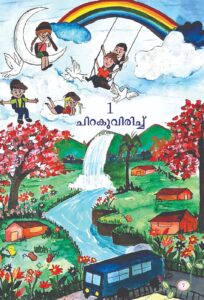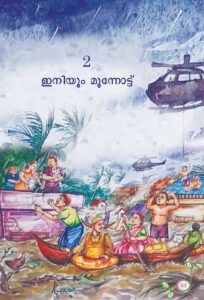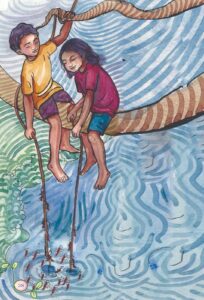The Kerala 'Padavali' Part I and II for Class IV students have been beautifully brought to life by a talented group of women illustrators — a landmark moment in the world of textbook creation in Kerala.
Published May 23, 2025 | 1:57 PM ⚊ Updated May 23, 2025 | 1:57 PM

An illustration in the Malayalam 'Padavali' Part 1 for Class IV students.
Synopsis: The Kerala State Council of Educational Research and Training roped in girl students and women artists to draw illustrations for two school textbooks.
More than new books, fresh uniforms, and timetables are awaiting students as schools across Kerala gear up to welcome them back on 2 June after a two-month summer break.
The upcoming academic year is bringing a quiet revolution in the pages of school textbooks. For the first time in the state’s history, two school textbooks, entirely illustrated by an all-women team of artists, will reach the students.
The Kerala Padavali (Kerala Reader) Part I and II for Class IV students have been beautifully brought to life by a talented group of women illustrators — a landmark moment in the world of textbook creation in Kerala.
As young minds flip through these pages, it’s not just a refreshing new beginning in language learning, but a bold chapter in women’s empowerment — breaking barriers, shattering stereotypes, and dismantling a space long held by men.
It’s worth noting that over 160 illustrations across these two textbooks were crafted by women artists — a vibrant collection that even includes clever optical illusions.
These illustrations aren’t just visually engaging: they subtly carry underlying messages and are designed to sharpen a child’s analytical thinking through art.
Widely considered as a remarkable move towards inclusivity and gender representation in academic spaces, the Kerala State Council of Educational Research and Training (SCERT) has, for the first time, entrusted an all-women team to illustrate school textbooks.

Illustrating for school textbooks demands the ability to think like a child, fully grasp the chapter’s message, and then creatively distill it into a single image.
The initiative covers Kerala Padavali Part I and II — textbooks for the fourth and sixth standards — for the upcoming academic year.
“It was a conscious effort,” Rajesh S Vallicodu, coordinator of the textbook writing committee and a research officer with SCERT, told South First. “Since 1997, I’ve been part of this committee, and women illustrators were rarely in the picture. This field has long remained male-dominated, especially when it comes to school textbooks. This time, we decided to bring in a difference.”
However, executing this vision was no easy task.
Rajesh said finding enough women illustrators willing to take on the demanding job of illustrating entire textbooks proved to be a challenge.
“We had a couple of women who’ve worked with us before, but burdening them alone wasn’t fair. When we approached others, many declined, citing existing assignments and payment concerns,” he recalled.
This led to what Rajesh fondly describes as a ‘women-hunt’.
He scoured weeklies, magazines, and published books, tracking down women illustrators whose work had caught his eye.
After much effort and careful filtering, a small, committed team was finally assembled. Adding a touching layer to the initiative, the illustration team also featured two students, Ananya S Subhash and Bianka Jansen.
Notably, Bianka is a differently-abled child with auditory processing disorder, who was identified through one of SCERT’s outreach camps for children with disabilities.
“We conveyed our feedback to Bianka through her mother, and she was incredibly receptive. She re-did illustrations whenever asked, with zero discomfort,” Rajesh shared.
Ananya, meanwhile, was already a familiar face, having illustrated for textbooks in the previous academic year.
When asked whether men or women illustrators were more flexible to work with in this context, Rajesh was candid. “Illustrating for school textbooks isn’t like other works. It demands the ability to think like a child, fully grasp the chapter’s message, and then creatively distill it into a single image. In my experience, women illustrators possess this sensitivity in greater measure. The ones who joined us did it out of love for children, investing their time and talent despite the challenges,” he said.
He added that while some men and even a few women illustrators hesitated to redo artworks when suggested by the textbook committee, the team that eventually came on board embraced the collaborative process wholeheartedly.
“I believe this is just the beginning,” Rajesh said with hope. “We need to create more spaces like this where women, including differently abled artists, find representation and recognition in shaping young minds, and that includes school textbook writing also.”
Earlier, hailing the initiative as a meaningful step in reclaiming creative spaces for women, General Education Minister V Sivankutty, through a social media post, stated that each illustration in the book has been crafted with children’s imagination, emotions, and developmental needs in mind.
“When our revised textbooks are released, one of them — the Malayalam textbook for Class 4 — will carve out its place in history. For the first time, a school textbook’s illustrations, in a field long dominated by patriarchy, have been entirely created by women and girl students,” he said.
“These illustrations spark curiosity and inspire thought. With a vibrant mix of styles and colours, every page brings learning to life, making concepts accessible, enjoyable, and child-friendly,” he added.
The minister also acknowledged the talented illustrators behind this visual storytelling revolution — students Ananya S Subhash and Bianka Jansen, along with Jayne, Sreeja Pallam, Aruna Alanchery, Seema CR Panchavarnam, Hima P Das, Anandavalli TK, and Nisha Ravindran.
South First caught up with two illustrators from this remarkable all-women team to get an inside look at the creative process behind breathing life into children’s textbooks.

Students Ananya S Subhash and Bianka Jansen, Jayne, Sreeja Pallam, Aruna Alanchery, Seema CR Panchavarnam, Hima P Das, Anandavalli TK, and Nisha Ravindran did the illustrations.
Veteran illustrator Aruna Alancheri, who has been in the field for over two decades and has previously collaborated with SCERT both as an illustrator and as a member of its art textbook committee, spoke about the nuances of the job.
“Usually, the SCERT provides us with the essence of a chapter, and it’s up to us to translate that into visuals,” she explained.
For Aruna, illustrating for children is a process of personal transformation.
“I’ve worked on illustrations for both adults and children, and the approach is entirely different. When it comes to children, we need to undergo a kind of metamorphosis — to become a child ourselves. Only then can we truly understand what captivates them. It’s no secret that bright colours draw their attention,” she smiled.
However, Aruna did share a concern faced by illustrators in the larger art community.
“It’s through illustrations that most people first step into the world of drawing. Despite this, some mainstream artists tend to look down on illustration and illustrators, conveniently forgetting that they too began their journeys with illustrations,” she observed.
When asked whether working on children’s textbooks poses a challenge, Aruna had a different perspective. “I wouldn’t call it challenging — it’s exciting! I love creating illustrations for children,” she beamed.

The illustrators ensured that the message was clear and child-friendly, leaving no room for confusion.
Speaking about the specific demands of this assignment, Sreeja Pallam, another veteran illustrator, said, “We had to carefully examine each chapter to assess how illustrations could enhance a child’s understanding of the lesson. A good illustration acts as a track — it either draws the child’s curiosity towards the topic or gently leads them to the lesson’s core message.”
She also highlighted the technical rigour involved.
“All the illustrations were done using watercolours. Often, we had to redo certain images multiple times to make sure the message was clear and child-friendly, leaving no room for confusion. Illustrating for children’s textbooks is a demanding process. There’s no scope for error because even a small mistake can trigger controversy.”
For both Aruna and Sreeja, this assignment was more than just work — it was a creative responsibility, an opportunity to shape young minds through colors, characters, and carefully crafted visuals.
They said, the rest of the team also had the same feeling: a quiet rebellion scripted in every stroke and shade.
(Edited by Majnu Babu).
